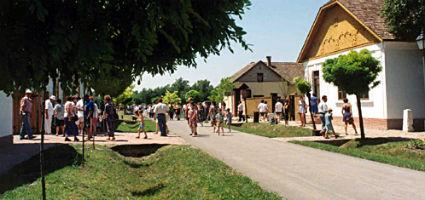2024. November 22. Friday
Ópusztaszer National Historic Memorial Park - Ópusztaszer
 |
Address: 6767, Ópusztaszer Szoborkert 68.
Phone number: (62) 275-133 /103, (62) 275-133 /104
E-mail: info@opusztaszer.hu
Opening hours: 01.04-30-10.: Tue-Sun 10-18
01.11-30.03.: Tue-Sun 10-16 (Skanzen, external exhibiton closed) The current fare for those interested informed about the institution's website: www.opusztaszer.hu |
The exhibition based on the rich findings and the models of buildings presents several centuries starting with the life of the Hungarians of the original settlement and ending with the destruction of the county town of Szer in 1956. Off course, we concentrate at the area of the monastery.
According to the material, we can separate five themes.
There is no written document of the original settlement, so we illustrate this period with the grave findings of the archeologists. Most of the material, jewelry, weapons and other tools, were found at the area of Szeged and Ópusztaszer.
The second theme gives information of the life of the settlement before the monastery was built.
The Benedictine lived first in the monastery, which was enlarged several times. Its history, which began in the 7th century, is the basis of the third theme. The rulers of the time were the Bor-Kalán who believed that they generated from chief Ond. The heydays of the monastery were at the reign of Béla III. (1172-1196).
The fourth theme is built around the settlement named Szer. It was rebuilt fast after the Tatar destroyed the country. Thanks to its geographic situation and the Pósa family, the village was soon given the title of a county town. The Turkish destroyed Szer in 1596. This is why it was renamed Pusztaszer.
There is also a nice collection of the coins issued by the Hungarian kings.
According to the material, we can separate five themes.
There is no written document of the original settlement, so we illustrate this period with the grave findings of the archeologists. Most of the material, jewelry, weapons and other tools, were found at the area of Szeged and Ópusztaszer.
The second theme gives information of the life of the settlement before the monastery was built.
The Benedictine lived first in the monastery, which was enlarged several times. Its history, which began in the 7th century, is the basis of the third theme. The rulers of the time were the Bor-Kalán who believed that they generated from chief Ond. The heydays of the monastery were at the reign of Béla III. (1172-1196).
The fourth theme is built around the settlement named Szer. It was rebuilt fast after the Tatar destroyed the country. Thanks to its geographic situation and the Pósa family, the village was soon given the title of a county town. The Turkish destroyed Szer in 1596. This is why it was renamed Pusztaszer.
There is also a nice collection of the coins issued by the Hungarian kings.
|
Related activities
|
|